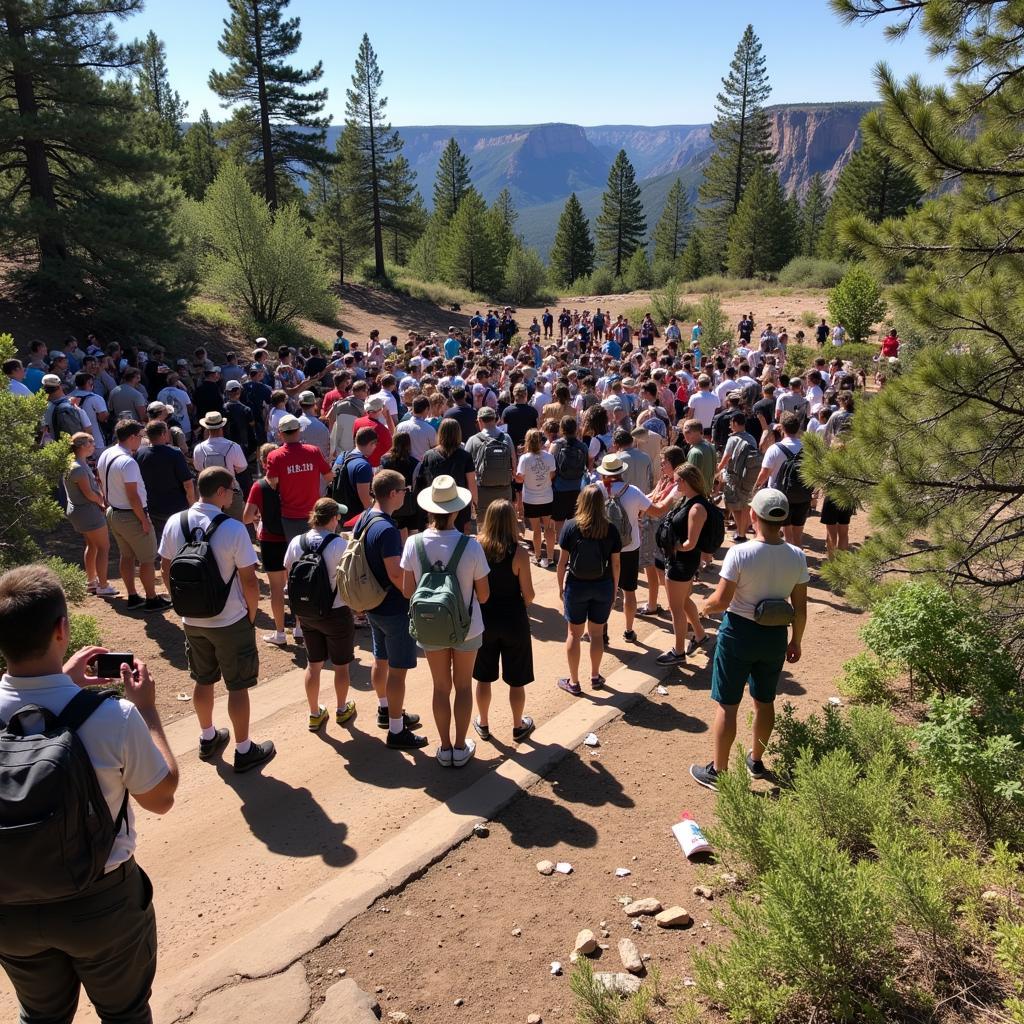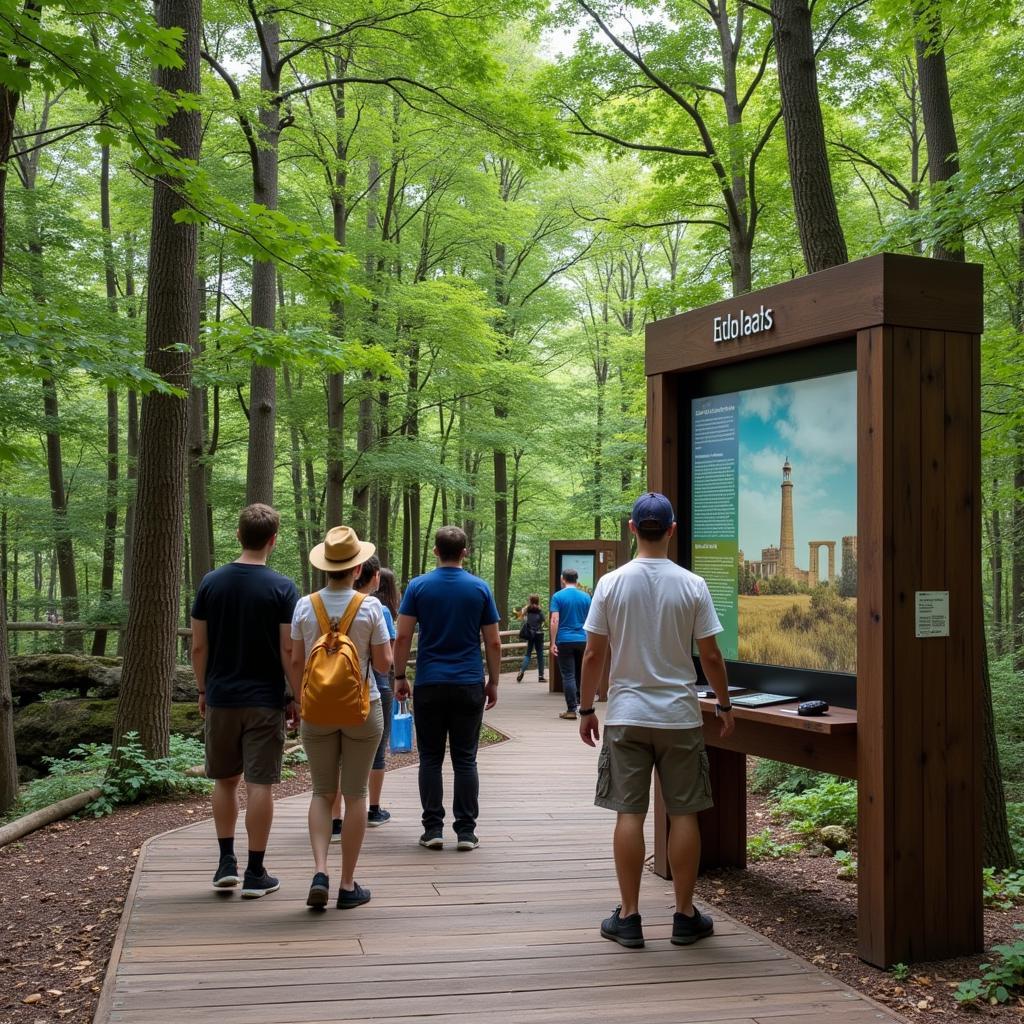National parks and tourism management has been a recurring theme in IELTS Writing Task 2, appearing approximately 2-3 times per year in recent exams. This topic intersects with environmental protection, sustainable development, and sustainable tourism in sensitive environments, making it highly relevant for future tests.
 Overcrowded national park showing environmental impact of mass tourism
Overcrowded national park showing environmental impact of mass tourism
Sample Question Analysis
Some people believe that national parks should strictly limit the number of visitors to protect the environment. Others think that public access to these natural areas should remain unrestricted. Discuss both views and give your opinion.
This question requires:
- Discussion of both perspectives
- Clear position statement
- Relevant examples and supporting evidence
- Balanced analysis of environmental protection vs public access
Band 8-9 Model Essay
Tourism and environmental conservation often present conflicting interests when it comes to managing national parks. While some advocate for strict visitor limitations to preserve these natural treasures, others emphasize the importance of unrestricted public access. In my view, a carefully regulated approach to visitor management is essential for sustainable park operations.
Proponents of visitor restrictions argue that limiting numbers is crucial for environmental protection. Heavy foot traffic can lead to soil erosion, habitat disruption, and wildlife disturbance. For instance, the overwhelming number of tourists in Yellowstone National Park has resulted in damaged thermal features and stressed wildlife populations. Moreover, overcrowding diminishes the natural experience that parks aim to provide, as evidenced by the long queues and noisy environments at popular viewpoints.
However, those opposing restrictions contend that public access to nature is a fundamental right that shouldn’t be curtailed. They maintain that national parks serve an educational purpose in fostering environmental awareness and appreciation for nature, similar to how how cultural diversity enriches societies. Furthermore, tourism revenue often funds conservation efforts and local communities’ development, making unrestricted access economically beneficial.
In my opinion, a balanced approach combining controlled access with strategic management is most effective. This could involve implementing timed entry systems, requiring advance reservations, and establishing carrying capacity limits based on scientific research. Such measures would ensure environmental protection while maintaining reasonable public access. Additionally, parks could introduce educational programs and alternative viewing areas to distribute visitor impact more evenly.
In conclusion, while unrestricted access may seem democratic, the long-term preservation of national parks necessitates some form of visitor management. The key lies in finding equilibrium between conservation and accessibility through smart, science-based policies.
 National park implementing sustainable tourism management practices
National park implementing sustainable tourism management practices
Band 6-7 Model Essay
The management of visitor numbers in national parks is a debated topic today. Some people think strict limits should be put on visitors, while others want parks to stay open for everyone. I will discuss both sides and share my thoughts.
People who support visitor limits have good reasons. First, too many visitors can damage nature. When lots of people walk on the same paths, it can cause erosion. Also, tourists often leave trash and disturb animals. For example, in Thailand’s Maya Bay, excessive tourism caused coral damage and forced the beach to close for recovery.
On the other hand, those against restrictions also make valid points. National parks help people learn about nature and the environment. If we limit visitors too much, fewer people will understand why we need to protect nature. Also, many parks need money from tourism to operate and protect wildlife.
I believe we should find a middle way. Parks could use systems like booking tickets in advance or having different visiting times. This would help control crowds while still letting people visit. They could also make some areas restricted and others more accessible.
To conclude, while protecting nature is important, completely restricting access isn’t the best solution. We should find ways to manage visitors better while keeping parks open for everyone to enjoy.
Analysis of Band Scores
Band 8-9 Essay Features:
- Sophisticated vocabulary and complex structures
- Clear progression of ideas
- Effective use of examples
- Coherent paragraphing and smooth transitions
- Well-developed arguments
Band 6-7 Essay Features:
- Simpler vocabulary but adequate for task
- Basic argument structure
- Limited range of complex sentences
- Some examples provided
- Clear but less sophisticated organization
Key Vocabulary
- carrying capacity (n) /ˈkæriɪŋ kəˈpæsəti/ – maximum sustainable number of visitors
- habitat disruption (n) /ˈhæbɪtæt dɪsˈrʌpʃən/ – interference with natural environments
- sustainable (adj) /səˈsteɪnəbəl/ – environmentally maintainable long-term
- conservation (n) /ˌkɒnsəˈveɪʃən/ – protection of natural resources
- erosion (n) /ɪˈroʊʒən/ – gradual destruction of surface material
- ecological impact (n) /ˌiːkəˈlɒdʒɪkəl ˈɪmpækt/ – effect on environment
- biodiversity (n) /ˌbaɪoʊdaɪˈvɜːrsəti/ – variety of life forms
- preservation (n) /ˌprezərˈveɪʃən/ – maintenance in original state
For practice, try writing your own essay addressing this topic and share it in the comments section. Consider also exploring related themes like eco-tourism management or wilderness preservation policies.


